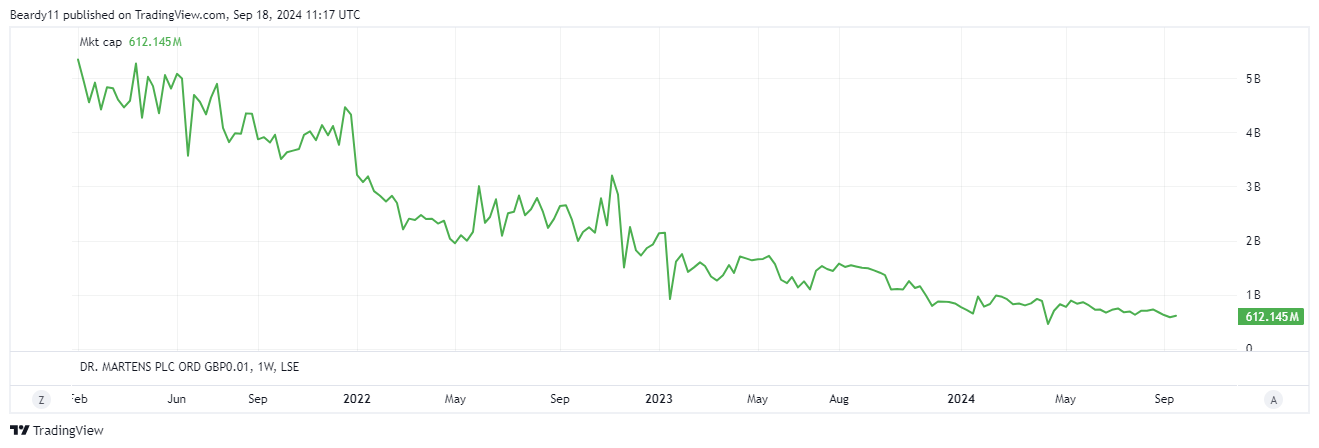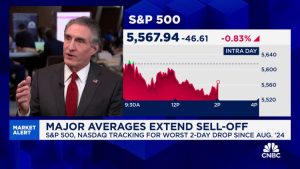When it listed in January 2021, Dr Martens (LSE:DOCS) had all the characteristics of a growth stock.
On the back of soaring sales and earnings, its IPO was heavily oversubscribed. Investors couldn’t get enough of the bootmaker and seemingly loved the fact that during the year ended 31 March 2020 (FY20), its revenue was 93% higher than in FY18.
It was cool to own both its boots and its shares.
In September 2019, the Irish Times ran a story with the headline: “How anti-fashion Dr Martens are more fashionable than ever” and described a “resurgence in popularity due to [the] influence of high-profile celebrities”. It wasn’t alone in hailing the business.
All this led to an impressive increase in its market cap which, at its peak, saw the group valued at over £4bn.
Chart by TradingView
Different times
How quickly things have changed.
A series of price increases and a drive to cut out wholesalers and sell directly to consumers meant its gross profit margin in FY24 was 65.6%. In FY18, it was 53.4%. This equates to £18.30 of extra profit on a pair of boots costing £150. Great.
But it now means sales are falling, particularly in the US, where the self-inflicted wound of mistakes in its new LA distribution centre added to its problems.
And after its fifth profits warning since becoming a listed company, its shares are now trading at a fraction of what they were in the heady days of 2021.
Mixed feelings
But I like the company and its brand. Since being formed in 1960, it’s become a British cultural and fashion icon. And it makes me sad to see it struggle.
However, when it comes to investing, it’s best to ignore emotions and focus on the facts. And these are that its sales are falling, earnings are in decline and there’s no immediate prospect of a quick recovery.
However, the company’s doing everything I’d expect in a turnaround situation. It’s replaced its boss, reduced capital expenditure, lowered inventory levels, cut costs and slashed its dividend by 44%.
And I take heart from the Abercrombie & Fitch story.
In 2016, it was voted the most hated retailer in America. Seven years later, after successfully managing to market its products to a slightly older customer base, its stock was the best performer on the S&P index.
Over the past year, its stock has risen 177%.
But Dr Martens is in a better position than its American cousin was in 2016.
As YouGov found in its most recent quarterly survey, it’s the fifth most popular fashion brand among Baby Boomers and placed eighth for Generation X.
| Category | Rank | Fame (%) | Popularity (%) |
|---|---|---|---|
| All | 13 | 95 | 56 |
| Millennials | 51 | 94 | 47 |
| Generation X | 8 | 100 | 64 |
| Baby Boomers | 5 | 96 | 62 |
| Men | 32 | 95 | 47 |
| Women | 6 | 96 | 67 |
However, with a pair of boots retailing for anything up to £210, it’s a far cry from fast fashion. And declining sales suggests some of its customers prefer cheaper alternatives.
What do I think?
I think the brand’s too popular not to recover. But there are no guarantees.
However, there’s presently too much uncertainty for me to part with my cash. The company’s largest shareholder recently sold 70m shares at a 9.8% discount to the prevailing market price.
It might take a while before the current turnaround plan is reflected in the bottom line. I’m therefore going to wait until the next trading update before making any decisions about whether to invest or not.
This post was originally published on Motley Fool






